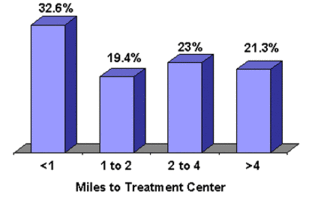The WAGER Vol. 9(42) – Clients on the Move
Past research has shown that clients who remain in addiction treatment longer have better outcomes (Condelli & Hubbard, 1994; Gossop, Marsden, Stewart, & Rolfe, 1999). Researchers and clinicians have identified and studied multiple factors that might lead some people to stay in treatment and others to drop out before completion. New research by Beardsley et al. (2003) suggests something as simple as how far clients must travel to reach the treatment center can affect how likely they are to continue treatment. This week’s WAGER discusses these findings and suggests implications for gambling treatment research and policy.
Counselors at state-funded substance abuse treatment programs in Baltimore City required to complete standardized forms on patient demographics and treatment. The information from these forms is entered into the Centralized Intake and Referral Management Information System (CIRMIS). Using this system, Beardsley et al. extracted data for all clients admitted and discharged for outpatient care during the fiscal year 1998. There were 1,735 clients from 30 different treatment programs who were eligible for inclusion (i.e., had not died during that year, were not incarcerated and had valid zip code information). Approximate distance traveled to the treatment program was calculated as the number of miles between the population centroid of the client’s zip code and the program location using straight-line calculations performed with MapInfo software. The researchers conducted multivariate logistic regression and multivariate regression to examine the impact of distance traveled, controlling for other demographic factors, on two dependent measures: (1) the completion of treatment (defined by the counselor as successful completion of the client’s treatment goals) and (2) on the length of stay in treatment (defined as time between admit and discharge).
The overall treatment completion rate was 23%. Distance to treatment contributed significantly to both models. Bivariate analyses revealed that clients who traveled less than a mile for treatment were significantly more likely to complete treatment than those who traveled a mile or more. The chance of completing treatment dropped by about 40% when clients had to travel greater than 1 mile; there was no significant difference between completion rates for any of the other distance groups (1-2 miles, 2-4 miles, greater than 4 miles), suggesting a threshold effect. Analyses using length of stay in treatment demonstrated a linear effect of distance, with length of stay decreasing as distance traveled increased (data not shown). The length of stay for a client living more than 4 miles from the treatment center was almost 13 days less than for a client living within 1 mile. The average length of stay for the study population was 68 days. Both models were significant, though they accounted for small amounts of variance in completion and length of stay (R2 = .05 and .04 respectively).
Figure 1. Percent of Clients in Each Distance Group that Completed Treatment (N = 1,735)

These results suggest that distance is an important determinant of treatment retention for a subset of clients in Baltimore. The results from this Baltimore study might not generalize to other populations or locales that have different characteristics from the study sample and venue. The researchers examined clients at publicly-funded treatment programs: for people with more resources at their disposal, distance might be a less important factor in treatment completion because of a greater ability to pay for transportation and disregard other opportunity costs. Further, this study was conducted in an urban setting; differences in transportation systems in a suburban or rural setting might influence the relationship between geographical distance and treatment completion.
Beardsley et al. found that addiction services that are more geographically accessible optimize retention. This has immediate implications for public health policy and planning. Redistributing treatment centers to be more geographically balanced is an important principle, but might be impractical and costly. Alternatively, there could be a shift in how public treatment seeking clients are assigned to centers. Since attendance at a particular treatment center is often dictated by the availability of treatment slots, policies that take geographical proximity into consideration when allocating treatment slots might contribute to increasing retention. While the above findings suggest distance is an obstacle to treatment retention, the results do not identify the mechanism by which distance exerts its effect. The relationship between distance and treatment retention could be a function of accessibility, transportation costs or travel time. The relationship between distance and treatment retention could be a function of accessibility, transportation costs or travel time. Once researchers have identified the mechanisms at play, they will be better able to respond with effective policy and planning.
Comments on this article can be addressed to Rachel Kidman.
References
Beardsley, K., Wish, E. D., Fitzelle, D. B., O’Grady, K., & Arria, A. M. (2003). Distance traveled to outpatient drug treatment and client retention. Journal of Substance Abuse Treatment, 25, 279–285.
Condelli, W., & Hubbard, R. (1994). Relationship between time spent in treatment and client outcomes for therapeutic communities. Journal of Substance Abuse Treatment, 11(1), 25-33.
Gossop, M., Marsden, J., Stewart, D., & Rolfe, A. (1999). Treatment retention and 1 year outcomes for residential programmes in England. Drug and Alcohol Dependence, 57, 89-98.